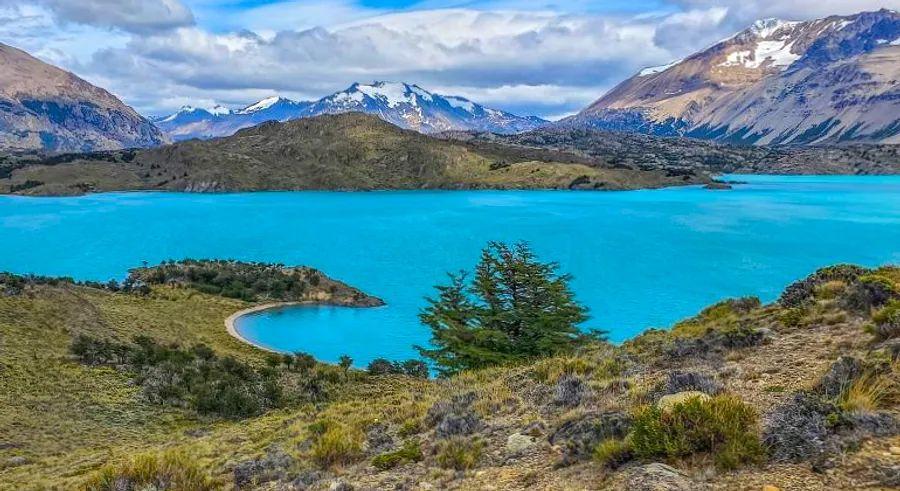A secluded Patagonia experience just for you

The condors gave away the secret.
Rather than gliding in wide circles on the high currents, a group of Andean condors flew low, occasionally landing awkwardly before rising again. They circled back and touched down again near the same spot on a dirt road within the park, clearly feeding. I was eager to see what they had discovered.
As I inched my way closer, the majestic birds shifted slightly and I carefully made my way through the tall grass by the roadside. What I found was a partially devoured young guanaco, its neck broken in the unmistakable style of a puma. Standing there, alone with the fresh kill and the watchful eyes of the condors, I felt as though I had stepped into a live episode of 'Wild Kingdom' with Marlin Perkins.
After months of exploring Patagonia's Argentina and Chile, I knew that having such a moment to myself in Argentina's Perito Moreno National Park was a rare treasure. With more travelers seeking the wild wonders of Patagonia, the crowds are becoming more frequent, especially in the region's most popular parks.

For instance, in Torres del Paine National Park, you'll encounter far more people than Andean condors. Located just a few hundred miles south in Chile's Patagonia, Torres del Paine saw 304,947 visitors in 2019 (despite its hefty entrance fee). Meanwhile, Perito Moreno National Park, free to enter, attracted just 272 people during its open season between October 1 and May 1, averaging about one visitor a day across its seven-month period.
So what keeps this park's visitor numbers so low? Its remote location (even by Patagonian standards) and its low-key reputation compared to more famous parks like Torres del Paine, make it a hidden gem – perfect for travelers seeking solitude and a true 'Wild Kingdom' experience.
Vast, diverse landscapes and Patagonia’s second highest peak await.
Perito Moreno National Park – distinct from the Perito Moreno Glacier further south – is named after Francisco “Perito” Moreno, an Argentine geographer, naturalist, anthropologist, and biologist. He is credited with establishing Argentina’s national park system after donating 18,500 acres to the government to create the country’s first national park.
Perito Moreno National Park was established to preserve its unique blend of Patagonian steppe grasslands, jagged peaks (including San Lorenzo Mountain, Patagonia's second tallest at 12,159 feet), glacial-fed rivers, pristine lakes free of invasive trout, and forests of resilient lenga beech trees with small leaves.

These varied landscapes provide a haven for guanacos (the wild relatives of llamas), endangered Andean condors, elusive pampas cats, flamingos, rheas (a bird resembling an ostrich), pumas, rare Geoffroy’s cats, and the endangered huemul deer.
In 1990, Doug Tompkins, the co-founder of Esprit and a seasoned outdoor adventurer, recognized the area’s natural wealth and purchased the El Rincón Ranch adjacent to the park. In 2014, his organization, Tompkins Conservation, donated the ranch to the Argentine National Parks Administration, expanding the park by 37,000 acres.
Blown by the wind and untamed
Today, Perito Moreno National Park covers over 313,400 acres, and recent improvements in infrastructure have made exploring the park more accessible.
Perito Moreno National Park now boasts 55 miles of hiking trails. On my visit, I trekked the Long Belgrano Peninsula Circuit (or Belgrano Circuito Grande in Spanish), which ended up being a nearly 13-mile loop. Despite clear signage, I missed a junction that would’ve led me straight back to the trailhead and instead skirted around a large hill.
I wasn’t complaining, though, as the mostly rolling trail led me through stunning lenga beech forests, vast grassy steppes, and the rugged shores of Belgrano Lake. To top it off, the only other hikers I encountered were a family of four and two couples.
The park also features nearly 60 miles of dirt roads that lead visitors to scenic viewpoints, offering stunning views of the park's landscapes. Whether you explore on foot or by vehicle, remember that the Patagonian weather is as much a part of the experience as the terrain, flora, and fauna. Prepare for a wide range of conditions and temperatures, and pay attention to wind warnings.
For instance, at the blufftop viewpoint overlooking Volcano Lake (Laguna Volcán), there’s a sign posted by rangers that reads “Cuidada en las días con viento fuerte” (Be cautious on days with strong winds). They mean it.
When I stopped there, the infamous Patagonian winds were so strong that I could hardly open the door of my truck. Once outside, it felt like the wind might knock me over. At Mie Lagoon, a popular spot for flamingos, a wooden blind provides a perfect hideaway for birdwatchers. The flamingos, defying their tropical image, wade through icy waters beneath the shadow of snow-capped mountains. The blind also offers welcome protection from the relentless wind.

Take your time and enjoy the journey
A single day isn’t enough to experience everything that Perito Moreno National Park has to offer. Thankfully, the park now has a chain of 10 wood cabins (known as refugios in Spanish), making it easier to spend a night or two here. However, they are temporarily closed due to the pandemic.
The cabins come in various sizes, accommodating groups of three to six people. Even if you don’t consider yourself the camping type, they’re hard to resist – and best of all, they’re free. Each cabin is equipped with bunk beds (bring your own sleeping bag), top-quality windows (no drafts), wood-burning stoves (with a generous supply of firewood), a basic cooking/dining/sitting area (bring your own stove and supplies), porches with lake views, and nearby eco-friendly outhouses.
To encourage further use of the cabins, a network of trails called Hidden Lakes (Lagos Escondidos) has been created, allowing hikers to traverse the park while spending nights in these cabins. For those who prefer, camping is also available in small lakeside campgrounds with level, smooth tent sites and bio outhouses. Two backcountry camping zones cater to those wanting to explore more remote areas, like San Lorenzo Mountain.
No matter how you decide to explore Perito Moreno National Park, you’re likely to experience the solitude and adventure that first drew you to Patagonia.
If you're planning a visit
Perito Moreno National Park is open from October 1st to the end of April.
Due to ongoing pandemic travel restrictions across Argentina, there are increased risks associated with travel. However, this park offers vast open spaces, fresh air, and is likely to remain uncrowded once international travel picks up again.
Entry to the park is free, as are the cabins (once they reopen after Covid) and campsites. To stay overnight in a cabin or campsite, you’ll need a reservation. Visit this link, and use the “Huts & Annex Tent Sites” tab under “Where to Sleep” to choose and book your spot. Most cabins allow a maximum stay of two nights.
To reach and explore Perito Moreno National Park, you'll need your own vehicle. It's located off Ruta Provincial 37, a bumpy 50-plus mile dirt road that connects with Argentina’s famous Ruta Nacional 40. Allow at least 90 minutes on RP 37 to reach the park entrance and ranger station.
A 4x4 vehicle isn’t required, but you will need good tires and enough ground clearance. Make sure your gas tank is full, and consider carrying extra fuel if you're concerned about covering more miles than your tank can handle. There are no fuel stations within or near the park.
Don’t mix up Perito Moreno National Park with the Perito Moreno Glacier (named after Francisco ‘Perito’ Moreno). The famous glacier is located near El Calafate, far from the park, hundreds of miles away.
If camping or staying in a cabin isn’t your style, you can still spend the night in Perito Moreno National Park by booking a room at Estancia La Oriental. The welcoming Lada family has transformed their sheep ranch farmhouse into a cozy, history-rich guesthouse.

1

2

3

4

5
Evaluation :
5/5